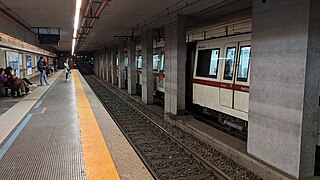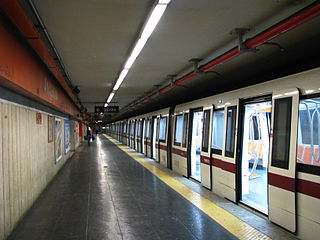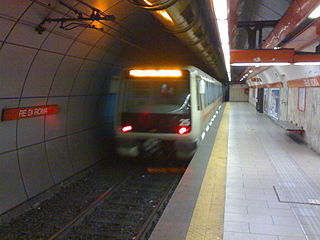
The Piazza di Spagna is a square in the centre of Rome, the capital of Italy. It lies at the foot of the Spanish Steps and owes its name to the Palazzo di Spagna, the seat of the Embassy of Spain to the Holy See. The Column of the Immaculate Conception is in the square.

Villa Borghese is a landscape garden in Rome, containing a number of buildings, museums and attractions. It is the third-largest public park in Rome, after the ones of the Villa Doria Pamphili and Villa Ada. The gardens were developed for the Villa Borghese Pinciana, built by the architect Flaminio Ponzio, developing sketches by Scipione Borghese, who used it as a villa suburbana, or party villa, at the edge of Rome, and to house his art collection. The gardens as they are now were remade in the late 19th century.

Campo Marzio is the 4th rione of Rome, Italy, identified by the initials R. IV. It belongs to the Municipio I and covers a smaller section of the area of the ancient Campus Martius. The logo of this rione is a silver crescent on a blue background.

The Acqua Vergine is one of several Roman aqueducts that deliver pure drinking water to Rome. Its name derives from its predecessor Aqua Virgo, which was constructed by Marcus Vipsanius Agrippa in 19 BC. Its terminal castellum is located at the Baths of Agrippa, and it served the vicinity of Campus Martius through its various conduits. In an effort to restore fresh water to Rome during the Renaissance, Pope Nicholas V, in 1453, renovated the main channels of the Aqua Virgo and added numerous secondary conduits under Campo Marzio. The original terminus, called a mostra, which means showpiece, was the stately, dignified wall fountain designed by Leon Battista Alberti in Piazza dei Crociferi. Due to several additions and modifications to the end-most points of the conduits during the years that followed, during the Renaissance and Baroque periods, the Acqua Vergine culminated in several magnificent mostre - the Trevi Fountain and the fountains of Piazza del Popolo.

Termini is an underground station of the Rome Metro. The station was inaugurated on 10 February 1955 as a station on Line B, and later became an interchange with Line A. The station is found in Piazza dei Cinquecento, under the Termini rail terminal. Together, the two stations form the main public transport hub in the city.

Cornelia is an underground station on Line A of the Rome Metro. It is located at the junction of Via di Boccea and the Circonvallazione Cornelia, from which it takes its name. The station was inaugurated on 1 January 2000.

Lepanto is an underground station on Line A of the Rome Metro. The station was inaugurated in 1980, and is at the junction of Viale Giulio Cesare with Via Lepanto and Via Marcantonio Colonna, in Prati.

Flaminio–Piazza del Popolo is an underground station on Line A of the Rome Metro, inaugurated in 1980. The station is situated on the large Piazzale Flaminio, in the Flaminio quarter outside the Aurelian Walls, next to Piazza del Popolo, and is near the Campus Martius.

Barberini–Fontana di Trevi is an underground station on Line A of the Rome Metro, inaugurated in 1980 and situated under Piazza Barberini in Trevi. Originally, the station was simply named Barberini, and the name was extended in 2000.

Repubblica–Teatro dell'Opera is an underground station on Line A of the Rome Metro. The station was inaugurated in 1980 and takes its name from the Piazza della Repubblica underneath which it lies.

Anagnina is a station of Line A of the Rome Metro. It is located at the junction between Via Tuscolana and Via Anagnina, close to the depot of Osteria del Curato. The station is at an altitude of 53 metres (174 ft) above sea level.

Cavour is a station on Line B of the Rome Metro, opened on 10 February 1955. It is located on via Cavour, in the Monti rione of Rome, midway between Santa Maria Maggiore and via dei Fori Imperiali.

Policlinico is a station on Line B of the Rome Metro. It is named after the nearby Policlinico Umberto I. It is located in Piazza Sassari, at the intersection with Viale Regina Margherita, Viale Regina Elena and Via Giovanni Maria Lancisi. It was opened in 1990.

Colosseo is a station on Line B of the Rome Metro. It was opened on 10 February 1955 and is located, as its name suggests, in the Monti rione on via del Colosseo near the Colosseum. The station is currently being expanded to be the new northern terminus of Metro's Line C.

The Rome tramway network composed of 6 tram lines operating in the city of Rome, Italy, part of the Rome’s public transport network. The current tram system in Rome, is a leftover from what once was the largest tram system in Italy. The system is owned and operated by Azienda Tranvie e Autobus del Comune di Roma.

Piola is a station of the Milan Metro, on line M2. The station grants direct access to the Politecnico di Milano (POLIMI).

ATAC S.p.A. is an Italian publicly owned company running most of the local public transportation services, paid parking and incentive parking lots in Rome. More specifically, the company handles, on behalf of Roma Capitale Authority, the entire tramway, trolleybus network and metro lines, as well as most of the bus lines in the city. It also operates, on behalf of the Administrative Region of Lazio, three railways: Roma-Civita Castellana-Viterbo, Roma-Giardinetti and Roma-Lido. ATAC S.p.A., with its 2,200-kilometer-wide public transport network, its over 8,500 busses and 70,000 parking stalls, is currently one of the biggest public transportation companies in Europe and the largest in Italy.

Re di Roma is a train station on the Rome Metro. It is on Line A and is located in Appio Latino, between San Giovanni and Ponte Lungo stations.

The following outline is provided as an overview of and topical guide to Rome:

The Piazza Euclide railway station is a railway station in Rome (Italy), on the Rome–Civitacastellana–Viterbo railway, managed by ATAC. It is the only underground stop of the line, excluding the Flaminio terminus.






















